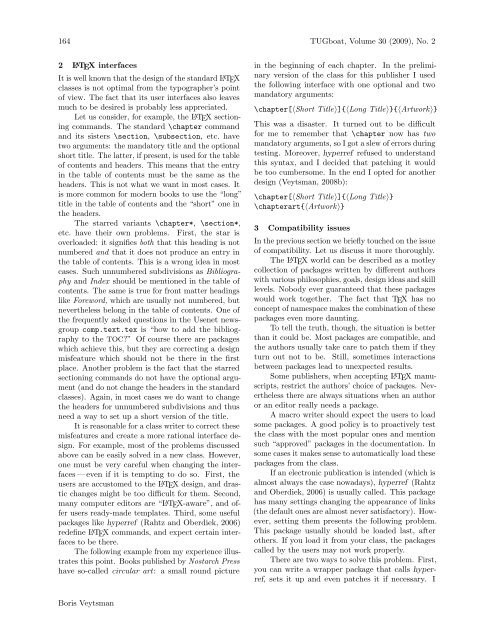The Communications of the TEX Users Group Volume 30 ... - TUG
The Communications of the TEX Users Group Volume 30 ... - TUG
The Communications of the TEX Users Group Volume 30 ... - TUG
Create successful ePaper yourself
Turn your PDF publications into a flip-book with our unique Google optimized e-Paper software.
164 <strong>TUG</strong>boat, <strong>Volume</strong> <strong>30</strong> (2009), No. 2<br />
2 L A<strong>TEX</strong> interfaces<br />
Itiswellknownthat<strong>the</strong>design<strong>of</strong><strong>the</strong>standardL A<strong>TEX</strong><br />
classes is not optimal from <strong>the</strong> typographer’s point<br />
<strong>of</strong> view. <strong>The</strong> fact that its user interfaces also leaves<br />
much to be desired is probably less appreciated.<br />
Let us consider, for example, <strong>the</strong> L A<strong>TEX</strong> sectioning<br />
commands. <strong>The</strong> standard \chapter command<br />
and its sisters \section, \subsection, etc. have<br />
two arguments: <strong>the</strong> mandatory title and <strong>the</strong> optional<br />
short title. <strong>The</strong> latter, if present, is used for <strong>the</strong> table<br />
<strong>of</strong> contents and headers. This means that <strong>the</strong> entry<br />
in <strong>the</strong> table <strong>of</strong> contents must be <strong>the</strong> same as <strong>the</strong><br />
headers. This is not what we want in most cases. It<br />
is more common for modern books to use <strong>the</strong> “long”<br />
title in <strong>the</strong> table <strong>of</strong> contents and <strong>the</strong> “short” one in<br />
<strong>the</strong> headers.<br />
<strong>The</strong> starred variants \chapter*, \section*,<br />
etc. have <strong>the</strong>ir own problems. First, <strong>the</strong> star is<br />
overloaded: it signifies both that this heading is not<br />
numbered and that it does not produce an entry in<br />
<strong>the</strong> table <strong>of</strong> contents. This is a wrong idea in most<br />
cases. Such unnumbered subdivisions as Bibliography<br />
and Index should be mentioned in <strong>the</strong> table <strong>of</strong><br />
contents. <strong>The</strong> same is true for front matter headings<br />
like Foreword, which are usually not numbered, but<br />
never<strong>the</strong>less belong in <strong>the</strong> table <strong>of</strong> contents. One <strong>of</strong><br />
<strong>the</strong> frequently asked questions in <strong>the</strong> Usenet newsgroup<br />
comp.text.tex is “how to add <strong>the</strong> bibliography<br />
to <strong>the</strong> TOC?” Of course <strong>the</strong>re are packages<br />
which achieve this, but <strong>the</strong>y are correcting a design<br />
misfeature which should not be <strong>the</strong>re in <strong>the</strong> first<br />
place. Ano<strong>the</strong>r problem is <strong>the</strong> fact that <strong>the</strong> starred<br />
sectioning commands do not have <strong>the</strong> optional argument<br />
(and do not change <strong>the</strong> headers in <strong>the</strong> standard<br />
classes). Again, in most cases we do want to change<br />
<strong>the</strong> headers for unnumbered subdivisions and thus<br />
need a way to set up a short version <strong>of</strong> <strong>the</strong> title.<br />
It is reasonable for a class writer to correct <strong>the</strong>se<br />
misfeatures and create a more rational interface design.<br />
For example, most <strong>of</strong> <strong>the</strong> problems discussed<br />
above can be easily solved in a new class. However,<br />
one must be very careful when changing <strong>the</strong> interfaces—even<br />
if it is tempting to do so. First, <strong>the</strong><br />
users are accustomed to <strong>the</strong> L A<strong>TEX</strong> design, and drastic<br />
changes might be too difficult for <strong>the</strong>m. Second,<br />
many computer editors are “L A<strong>TEX</strong>-aware”, and <strong>of</strong>fer<br />
users ready-made templates. Third, some useful<br />
packages like hyperref (Rahtz and Oberdiek, 2006)<br />
redefine L A<strong>TEX</strong> commands, and expect certain interfaces<br />
to be <strong>the</strong>re.<br />
<strong>The</strong> following example from my experience illustrates<br />
this point. Books published by Nostarch Press<br />
have so-called circular art: a small round picture<br />
Boris Veytsman<br />
in <strong>the</strong> beginning <strong>of</strong> each chapter. In <strong>the</strong> preliminary<br />
version <strong>of</strong> <strong>the</strong> class for this publisher I used<br />
<strong>the</strong> following interface with one optional and two<br />
mandatory arguments:<br />
\chapter[〈Short Title〉]{〈Long Title〉}{〈Artwork〉}<br />
This was a disaster. It turned out to be difficult<br />
for me to remember that \chapter now has two<br />
mandatoryarguments, soIgotaslew<strong>of</strong>errorsduring<br />
testing. Moreover, hyperref refused to understand<br />
this syntax, and I decided that patching it would<br />
be too cumbersome. In <strong>the</strong> end I opted for ano<strong>the</strong>r<br />
design (Veytsman, 2008b):<br />
\chapter[〈Short Title〉]{〈Long Title〉}<br />
\chapterart{〈Artwork〉}<br />
3 Compatibility issues<br />
In<strong>the</strong>previoussectionwebrieflytouchedon<strong>the</strong>issue<br />
<strong>of</strong> compatibility. Let us discuss it more thoroughly.<br />
<strong>The</strong> L A<strong>TEX</strong> world can be described as a motley<br />
collection <strong>of</strong> packages written by different authors<br />
withvariousphilosophies, goals, designideasandskill<br />
levels. Nobody ever guaranteed that <strong>the</strong>se packages<br />
would work toge<strong>the</strong>r. <strong>The</strong> fact that <strong>TEX</strong> has no<br />
concept<strong>of</strong>namespacemakes<strong>the</strong>combination<strong>of</strong><strong>the</strong>se<br />
packages even more daunting.<br />
To tell <strong>the</strong> truth, though, <strong>the</strong> situation is better<br />
than it could be. Most packages are compatible, and<br />
<strong>the</strong> authors usually take care to patch <strong>the</strong>m if <strong>the</strong>y<br />
turn out not to be. Still, sometimes interactions<br />
between packages lead to unexpected results.<br />
Some publishers, when accepting L A<strong>TEX</strong> manuscripts,<br />
restrict <strong>the</strong> authors’ choice <strong>of</strong> packages. Never<strong>the</strong>less<br />
<strong>the</strong>re are always situations when an author<br />
or an editor really needs a package.<br />
A macro writer should expect <strong>the</strong> users to load<br />
some packages. A good policy is to proactively test<br />
<strong>the</strong> class with <strong>the</strong> most popular ones and mention<br />
such “approved” packages in <strong>the</strong> documentation. In<br />
some cases it makes sense to automatically load <strong>the</strong>se<br />
packages from <strong>the</strong> class.<br />
If an electronic publication is intended (which is<br />
almost always <strong>the</strong> case nowadays), hyperref (Rahtz<br />
and Oberdiek, 2006) is usually called. This package<br />
has many settings changing <strong>the</strong> appearance <strong>of</strong> links<br />
(<strong>the</strong> default ones are almost never satisfactory). However,<br />
setting <strong>the</strong>m presents <strong>the</strong> following problem.<br />
This package usually should be loaded last, after<br />
o<strong>the</strong>rs. If you load it from your class, <strong>the</strong> packages<br />
called by <strong>the</strong> users may not work properly.<br />
<strong>The</strong>re are two ways to solve this problem. First,<br />
you can write a wrapper package that calls hyperref,<br />
sets it up and even patches it if necessary. I

















